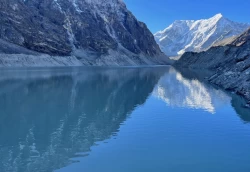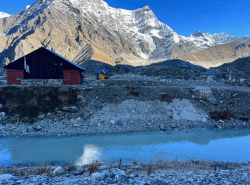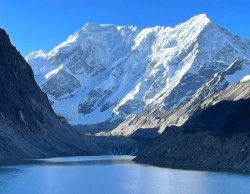Climate
By Seth Borenstein
The world’s glaciers are shrinking and disappearing faster than scientists thought, with two-thirds of them projected to melt out of existence by the end of the century at current climate change trends, according to a new study.
But if the world can limit future warming to just a few more tenths of a degree and fulfil international goals — technically possible but unlikely according to many scientists — then slightly less than half the globe’s glaciers will disappear, said the same study.
Mostly small but well-known glaciers are marching to extinction, study authors said.
In an also unlikely worst-case scenario of several degrees of warming, 83% of the world’s glaciers would likely disappear by the year 2100, study authors said.
The study in Thursday’s journal Science examined all of the globe’s 215,000 land-based glaciers -- not counting those on ice sheets in Greenland and Antarctica -- in a more comprehensive way than past studies. Scientists then used computer simulations to calculate, using different levels of warming, how many glaciers would disappear, how many trillions of tons of ice would melt, and how much it would contribute to sea level rise.
Also Read: Ten times Everest climber Lhakpa Sherpa concerned about melting glaciers
The world is now on track for a 2.7-degree Celsius (4.9 degrees Fahrenheit) temperature rise since pre-industrial times, which by the year 2100 means losing 32% of the world’s glacier mass, or 48.5 trillion metric tons of ice as well as 68% of the glaciers disappearing. That would increase sea level rise by 4.5 inches (115 millimetres) in addition to seas already getting larger from melting ice sheets and warmer water, said study lead author David Rounce.
“No matter what, we’re going to lose a lot of the glaciers,” Rounce, a glaciologist and engineering professor at Carnegie Mellon University, said. “But we have the ability to make a difference by limiting how many glaciers we lose.”
“For many small glaciers it is too late,” said study co-author Regine Hock, a glaciologist at the University of Alaska Fairbanks and the University of Oslo in Norway. “However, globally our results clearly show that every degree of global temperature matters to keep as much ice as possible locked up in the glaciers.”
Projected ice loss by 2100 ranges from 38.7 trillion metric tons to 64.4 trillion tons, depending on how much the globe warms and how much coal, oil and gas is burned, according to the study.
The study calculates that all that melting ice will add anywhere from 3.5 inches (90 millimetres) in the best case to 6.5 inches (166 millimetres) in the worst case to the world’s sea level, 4% to 14% more than previous projections.
That 4.5 inches of sea level rise from glaciers would mean more than 10 million people around the world — and more than 100,000 people in the United States — would be living below the high tide line, who otherwise would be above it, said sea level rise researcher Ben Strauss, CEO of Climate Central. Twentieth-century sea level rise from climate change added about 4 inches to the surge from 2012 Superstorm Sandy costing about $8 billion in damage just in itself, he said.
Scientists say future sea level rise will be driven more by melting ice sheets than glaciers.
But the loss of glaciers is about more than rising seas. It means shrinking water supplies for a big chunk of the world’s population, more risk from flood events from melting glaciers and about losing historic ice-covered spots from Alaska to the Alps to even near Mount Everest’s base camp, several scientists told The Associated Press.
“For places like the Alps or Iceland... glaciers are part of what makes these landscapes so special,” said National Snow and Ice Data Centre Director Mark Serreze, who wasn’t part of the study but praised it. “As they lose their ice in a sense they also lose their soul.”
Hock pointed to Vernagtferner glacier in the Austrian Alps, which is one of the best-studied glaciers in the world, but said “the glacier will be gone.”
The Columbia Glacier in Alaska had 216 billion tons of ice in 2015, but with just a few more tenths of a degree of warming, Rounce calculated it will be half that size. If there’s 4 degrees Celsius (7.2 degrees Fahrenheit) of warming since pre-industrial times, an unlikely worst-case scenario, it will lose two-thirds of its mass, he said.
“It’s definitely a hard one to look at and not drop your jaw at,” Rounce said.
Glaciers are crucial to people’s lives in much of the world, said National Snow and Ice Center Deputy Lead Scientist Twila Moon, who wasn’t part of the study.
“Glaciers provide drinking water, agricultural water, hydropower, and other services that support billions (yes, billions!) of people,” Moon said in an email. Moon said the study “represents significant advances in projecting how the world’s glaciers may change over the next 80 years due to human-created climate change.”
That’s because the study includes factors in glacier changes that previous studies didn’t and is more detailed, said Ruth Mottram and Martin Stendel, climate scientists at the Danish Meteorological Institute who weren’t part of the research.
This new study better factors in how the glaciers’ ice melts not just from warmer air, but water both below and at the edges of glaciers and how debris can slow melt, Stendel and Mottram said. Previous studies concentrated on large glaciers and made regional estimates instead of calculations for each individual glacier.
In most cases, the estimated loss figures Rounce’s team came up with are slightly direr than earlier estimates.
If the world can somehow limit warming to the global goal of 1.5 degrees Celsius (2.7 degrees Fahrenheit) of warming since pre-industrial times -- the world is already at 1.1 degrees (2 degrees Fahrenheit) -- Earth will likely lose 26% of total glacial mass by the end of the century, which is 38.7 trillion metric tons of ice melting. Previous best estimates had that level of warming melting translating to only 18% of total mass loss.
“I have worked on glaciers in the Alps and Norway which are really rapidly disappearing,” Mottram said in an email. “It’s kind of devastating to see.”
Half the planet’s glaciers will have melted by 2100 even if humanity sticks to goals set out in the Paris climate agreement, according to research that finds the scale and impacts of glacial loss are greater than previously thought. At least half of that loss will happen in the next 30 years.
Researchers found 49% of glaciers would disappear under the most optimistic scenario of 1.5C of warming. However, if global heating continued under the current scenario of 2.7C of warming, losses would be more significant, with 68% of glaciers disappearing, according to the paper, published in Science. There would be almost no glaciers left in central Europe, western Canada and the US by the end of the next century if this happened.
This will significantly contribute to sea level rise, threaten the supply of water of up to 2 billion people, and increase the risk of natural hazards such as flooding. The study looked at all glacial land ice except for Greenland and Antarctic ice sheets.
If temperature increases are limited to 1.5C of warming, average sea levels would increase by 90mm (3.5in) from 2015 to 2100, but with 2.7C of warming, glacial melt would lead to around 115mm of sea level rise. These scenarios are up to 23% more than previous models had estimated.
Mountain glacier melt is believed to contribute to more than a third of sea level rise. A lot of this loss is unavoidable, but the magnitude of loss is directly related to temperature increases, so acting on the climate crisis is key.
Researchers wrote in the paper: “The rapidly increasing glacier mass losses as global temperature increases beyond 1.5C stresses the urgency of establishing more ambitious climate pledges to preserve the glaciers in these mountainous regions.”
Ships carrying less than 500 passengers are permitted to make landings in Antarctica. The green vest identifies a staff member who plays an important role in interpretation as well as crowd control and environmental protection. The telephoto lens makes this ship look like it’s parked on the beach when in fact it is a safe distance offshore.
The team used two decades of satellite data to map the planet’s glaciers with greater precision than ever before. Previous models had relied on measurements of specific glaciers, and that information was then extrapolated, but now researchers could get data points on each of the planet’s 200,000 glaciers.
For the first time, this gave them insight into how many would be lost under different climate change scenarios.
The study’s lead author, Dr David Rounce, a civil and environmental engineer from Carnegie Mellon University and the University of Alaska Fairbanks, said: “This is the first time we have isolated the number of glaciers that will be lost – before it was the total mass loss.”
Most of the glaciers that will be lost are small, currently less than 1 sq km. Although they contribute less to the total volume, they are most vulnerable to change. This is why the total loss of mass is less – so, for example, under the 2.7C scenario 68% of glaciers will be lost but the relative mass is less – projected to be 32%.
Small glaciers are an important source of water and livelihood for millions of people. Rounce said: “When we think about the locations where most people see and visit glaciers, it’s really in locations where they’re accessible, like in central Europe, or in high mountain Asia. In these regions there are a lot of smaller glaciers. They’re really at the core of the societies and economies of those locations.”
Lower mountain ranges such as the Alps and the Pyrenees are among those worst affected. In the Alps, for example, by 2050, glaciers are expected to be on average 70% smaller, many of the smaller ones would have already disappeared, with snow tops replaced by bare rock in some locations, and with significant losses in biodiversity as a result.
Alpine flowers could become extinct after glaciers disappear as more competitive species colonise terrain higher up the mountain. Proglacial environments are highly sensitive to global heating, and mountain species are subject to the “escalator to extinction”.
This is not the first research to project sea level rise from glacial melt, but the projections are more accurate than previous models. It follows research from 2021 that found the speed of glacial melt had doubled in the past two decades, contributing more to sea level rise than either the Greenland or Antarctic ice sheets.
Prof Antonio Ruiz de Elvira, from the University of Alcalá, who was not involved in the paper, said all existing evidence was consistent with the results. He said: “The study makes much of the earlier partial data more concrete.”
In emphasising the importance of glaciers, he said: “In California, the water needed to sustain agriculture comes from glaciers directly from the end of July. In Spain, the disappearance of the Sierra Nevada glaciers means an almost complete reduction in water availability there from that time onwards, and the same applies to the glaciers in the Pyrenees. In India and China, they depend crucially on the Himalayan glaciers.” -AP/RSS






